|
|
 |
Fiche d'espèce de Copépode |
|
|
Calanoida ( Ordre ) |
|
|
|
Lucicutiidae ( Famille ) |
|
|
|
Lucicutia ( Genre ) |
|
|
| |
Lucicutia bicornuta Wolfenden, 1905 (F,M) | |
| | | | | | | Syn.: | Lucicutia aurita Sars, 1905 c (p.8);
L. bicornis : Sars, 1907 a (p.3);
L. bicornutum : Lee & al., 1971 (p.1151) | | | | Ref.: | | | Wolfenden, 1905 a (p.24, Descr.F,M, fig.M); A. Scott, 1909 (p.126, figs.M); Wolfenden, 1911 (p.321, figs.F,M); Sars, 1925 (p.214, figs.M); Sewell, 1932 (p.290); Lysholm & al., 1945 (p.34); Sewell, 1947 (p.173); Brodsky, 1950 (1967) (p.338, figs.F,M, Rem.); Tanaka, 1963 (p.51, figs.F,M); Vervoort, 1965 (p.115, Rem.); Owre & Foyo, 1967 (p.76, figs.F,M); Hülsemann, 1966 (p.707, figs.F); Gardner & Szabo, 1982 (p.356, figs.F,M); Chihara & Murano, 1997 (p.830: tab.5); Bradford-Grieve & al., 1999 (p.883, 945, figs.F,M); Bradford-Grieve,1999 b (p.95, figs.F,M, Rem., figs.176, 191); Boxshall & Halsey, 2004 (p.132: F; p.133: M); Vives & Shmeleva, 2007 (p.350, figs.F,M, Rem.) | 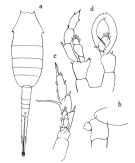 issued from : O. Tanaka in Publs Seto Mar. Biol. Lab., 1963, XI (1). [p.52, Fig.178]. Female: a, habitus (dorsal); b, last thoracic segment and genital somite (left lateral side); c, P5. Nota: The urosome segments and furca are in the proportional lengths as 19:8:8:12:53 = 100. Male: d, P5.
|
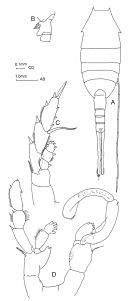 issued from : J.M. Bradford-Grieve in The Marine Fauna of New Zealand: Pelagic Calanoid Copepoda. National Institute of Water and Atmospheric Research (NIWA). NIWA Biodiversity Memoir, 111, 1999. [p.95, Fig.61]. Female (41°47'S, 175°01'E: A, habitus (dorsal); B, genital somite (left lateral side); C, P5. Male: D, P5. Nota: The P5 males differ slightly from Wolfenden's (1911) figure.
|
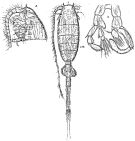 Issued from : G.O. Sars in Résult. Camp. Scient. Prince Albert I, 69, pls.1-127 (1924). [Pl.LVIII, figs.1-3]. Male: 1, habitus (dorsal); 2, forehead (lateral); 3, P5.
|
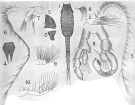 issued from : A. Scott in Siboga-Expedition, 1909, XIX a. [Plate XXXIX, Figs.1-11]. Male (from Banda Sea): 1, habitus (dorsal); 2, forehead (lateral); 3, last thoracic and genital segments (left side); 4, rostrum; 5, right A1; 6, left A1; 7, A2; 8, Md; 9, Mx2; 10, Mxp; 11, P5.
|
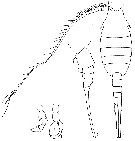 issued from : R.N. Wolfenden in Die Marinen Copepoden der Deutschen Südpolar-Expedition 1901-1903, 1911. [p.322, Fig.63]. Female: b, posterior part cephalothorax and urosome (lateral). Male: a, habitus (dorsal); c-d, P5.
|
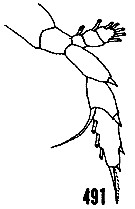 issued from : H.B. Owre & M. Foyo in Fauna Caribaea, 1, Crustacea, 1: Copepoda. Copepods of the Florida Current. 1967. [p.76, Fig.491]. Female (from 15°00'N, 67°05'W): 491, P5.
|
 Lucicutia bicornuta Lucicutia bicornuta female: 1 - Characters following not combined : Prosome about 3 times longer than urosome. Cephalosome with slightly projecting and rounded anterior corners and well developed lateral spinous projections; anal somite about as long as wide; caudal rami 11.7 times longer than wide and bowed outwards at base, leaving elliptical space between rami proximally. 2 - P1 with 3-segmented endopod. 3 - Cephalosome with 2 pairs of spinous projections (1 anterolateral and 1 lateral). 4 - Anterolateral projections strong, directed frontally. Lateral margins of anal somite straight. Caudal rami longer than urosome.
|
 Lucicutia bicornuta Lucicutia bicornuta male: 1 - P1 with 3-segmented endopod. 2 - Cephalosome with 2 pairs of spinous projections (1 anterolateral and 1 lateral). 3 - Anterolateral projections strong; lateral projections directed posteriorly.
| | | | | Ref. compl.: | | | Wilson, 1942 a (p.192); Sewell, 1948 (p.331, 503, 514, 525, 526, 547, 549, 567); Grice & Hulsemann, 1967 (p.17); 1968 (tab.2); Park, 1970 (p.477); Björnberg, 1973 (p.343, 387); Deevey & Brooks, 1977 (p.256, tab.2, Station "S"); Vives, 1982 (p.293); Lozano Soldevilla & al., 1988 (p.59); Wiebe & al., 1988 (tab.7); Heinrich, 1990 (p.18); Madhupratap & Haridas, 1990 (p.305, fig.3: vertical distribution night/day; fig.7: cluster); Shih & Young, 1995 (p.70); Lapernat, 2000 (tabl.3, 4); Hsiao & al., 2004 (p.326, tab.1); Ikeda & al., 2006 (p.1791,Table 2); Hwang & al., 2007 (p.24); Morales-Ramirez & Suarez-Morales, 2008 (p.520); Galbraith, 2009 (pers. comm.); Medellin-Mora & Navas S., 2010 (p.265, Tab. 2); Takenaka & al., 2012 (p.1669, fig.2, 3, Table 1, bioluminescence) | | | | NZ: | 16 | | |
|
Carte de distribution de Lucicutia bicornuta par zones géographiques
|
| | | | | | | | |  Issued from : M. Madhupratap & P. Haridas in J. Plankton Res., 12 (2). [p.310, Fig.3]. Issued from : M. Madhupratap & P. Haridas in J. Plankton Res., 12 (2). [p.310, Fig.3].
Vertical distribution of calanoid copepod (mean +1 SE), abundance No/100 m3. 14- Lucicutia bicornuta.
Night: shaded, day: unshaded.
Samples collected from 6 stations located off Cochin (India), SE Arabian Sea, November 1983, with a Multiple Closing Plankton Net (mesh aperture 300 µm), in vertical hauls at 4 depth intervalls (0-200, 200-400, 400-600, 600-1000 m). |
| | | | Loc: | | | South Africa, off da Trindade Is., Brazil (NE Cape San Roque), G. of Guinea, off NE Cape Verde Is., off Mauritania, Morocco-Mauritania, Canary Is., off W Azores, Caribbean Sea, Caribbean Colombia, Florida, off Bermuda 'Station "S"), Sargasso Sea, Arabian Sea, Indian, Bay of Bengal, Indonesia-Malaysia, China Seas (East China Sea, South China Sea), Taiwan (S é E), Japan (Suruga Bay, NE), off SE Hokkaido, Pacif. NW & NE (Strait of Queen Charlotte), Guaymas Basin, W Costa Rica, S Kuril Is., Pacif. (SE tropical), S Easter Is., off Juan Fernandez Is., Chile ( N & S ), New Zealand (SW & SE North Island) | | | | N: | 39 | | | | Lg.: | | | (1) M: 6,9; (5) M: 8; (10) F: 6,75; M: 6,7; (21) F: 8,4-6,8; M: 7,7-6,9; (22) F: 6,8; (26) F: 7,51; M: 7; (909) F: 7,4-7,5; M: 6,5-7,25; {F: 6,75-8,40; M: 6,50-8,00}
| | | | Rem.: | Abysso & bathypélagique.
Voir aussi les remarques en anglais | | | Dernière mise à jour : 01/12/2025 | |
|
|
 Toute utilisation de ce site pour une publication sera mentionnée avec la référence suivante : Toute utilisation de ce site pour une publication sera mentionnée avec la référence suivante :
Razouls C., Desreumaux N., Kouwenberg J. et de Bovée F., 2005-2025. - Biodiversité des Copépodes planctoniques marins (morphologie, répartition géographique et données biologiques). Sorbonne Université, CNRS. Disponible sur http://copepodes.obs-banyuls.fr [Accédé le 29 décembre 2025] © copyright 2005-2025 Sorbonne Université, CNRS
|
|
 |
 |










